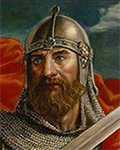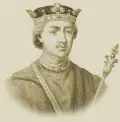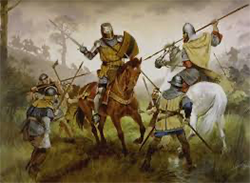Ireland in the Middle Ages
Ireland in the Middle Ages continued to be a collection of kingdoms that rose and fell in power and importance, at times occupied to varying degrees by English troops and ruled by English kings. Brian Boru's victory at the Battle of Clontarf in 1014 resulted in the defeat of the Kingdom of Leinster and the Viking force from Dublin. However, because not only Boru but also his son and grandson were killed in the battle, a power struggle ensued. The various kingdoms once again struggled to achieve dominance over another. However, the Viking threat was fading. Against this backdrop, the Christian Church grew. Membership increased, and a series of high-level meetings at Cashel, Rath Breasail, and Kells resulted in a reorganization that didn't exactly please the head of the Catholic Church, Pope Adrian IV. The pope granted England's King Henry II the right to step in and influence things in Ireland. Henry usually preferred the direct approach; in this case, however, he waited for the right opportunity. 
In 1166, King of Leinster Dermait MacMurrough traveled to England to ask Henry II for help in reclaiming his realm. Henry gave MacMurrough leave to recruit English soldiers, led by Richard FitzGilbert de Clare, otherwise known as Strongbow (right). To seal the deal, MacMurrough pledged that Strongbow could marry the king's daughter and thus inherit the kingdom after the king's death. Strongbow and an armed force of English soldiers arrived in 1169, landing near Wexford and capturing that town. Rory O'Connor, the high king at the time, led an army of resistance, and any further conflict ended when MacMurrough agreed to recognize O'Connor as high king. That wasn't enough for Strongbow. He gathered another armed force a year later and returned, capturing Waterford and Dublin. A force from the high king intended to lay siege to Dublin got the surprise of its life when Strongbow and his army rode out to meet them and then defeated them. 
Henry II (left) recalled all English soldiers. Strongbow didn't want to return and convinced the English king to let him carry on. Henry's price was ownership of Dublin, Waterford, and Wexford. Strongbow, knowing that he would get Leinster when MacMurrough died, agreed. The succession went according to plan in 1171; in that same year, Henry II himself came to Ireland, and Strongbow duly submitted to the English king, as did a number of other Irish kings. The final step in the process was the submission of the high, Rory O'Connor, in 1175. By the terms of the Treaty of Windsor, England ruled Ireland. Henry set up a feudal system, along the lines of the one already running smoothly in England, and made sure that a number of Norman nobles had settled in to owning large estates in their new home of Ireland, then returned to England. He was in Ireland all of seven months. In 1177, Henry named his youngest son, John, Lord of Ireland. John was all of 10 years old. John didn't go to Ireland for another eight years, and so he was 18 when he arrived as essentially the ruling monarch. He didn't wear the crown, however, because Pope Lucius III refused to agree to so recognize John. When John became king in 1199, he was by default the crown-wearing Lord of Ireland. He did finally visit Ireland again in 1210, to ensure that the Norman lords retained their fealty to the Crown. As the 13th Century progressed, England was more and more consumed with internal problems, and Irish kings had time and space to build up armies. King of Desmond Fineen MacCarthy scored a victory over a Norman army at the Battle of Callann in 1261. For another several decades, the struggle between Irish and Norman-Englishman carried on. The first Irish parliament convened in 1297, following the English model of summoning knights and noblemen from the wealthier areas; a subsequent parliament at the turn of the century includes representatives from the towns as well. 
The Scottish victory over the English at Bannockburn in 1314 emboldened the Irish kings to make a similar attempt. A number of Irish leaders offered the Irish crown to Edward Bruce, whose older brother was Robert the Bruce, the hero of Bannockburn. Edward agreed and led a 6,000-man-strong army onto Irish lands in 1315. The Scottish-Irish combination proved successful at first, and the Irish crowned Edward king at Dundalk in 1316. Robert the Bruce arrived with reinforcements the following year, and the invaders had success across much of the country. They didn't take Dublin, however. Proving the importance that one man can have, the Irish agreed to end the uprising when King Edward Bruce died at a battle in 1318. Ireland wasn't immune to the horrors of the Black Death; that dread disease arrived on Irish shores in 1348. The rural lifestyle of the Irish proved to their advantage in that the cities densely populated with Normans and English were prime incubators for the bubonic plague. The killer of one-third of Europe was devastatingly effective in Ireland as well. Irish parliaments continued to meet and adopt laws. The 1366 Statutes of Kilkenny forbade marriage between native Irish and Anglo-Irish. It was an attempt to keep the two peoples separate, along with kindler, gentler prohibitions against non-Irishmen wearing Irish dress or playing the Irish game of hurling. Seeing Ireland slipping away, King Richard II arrived in 1394 and convinced the Irish kings to submit to him. They soon reneged on their promise, and Richard returned in 1399. In that year, however, he faced a rebellion and went home to deal with it. He never returned. Into the 15th Century, the amount of territory that England controlled in Ireland was an area near Dublin called the Pale. England–more and more concerned with fighting France in the Hundred Years War, fighting Scotland from time to time, and trying not to be consumed by the internecine Wars of the Roses–had little time to worry about reinserting itself in the complicated world of Irish politics. That changed once Henry Tudor had won the Wars of the Roses and become King Henry VII. In 1494, the Lord Deputy of Ireland, Sir Edward Poynings, summoned the Irish parliament and announced that it would be placed under the authority of the English parliament. Poynings convinced the Irish parliament to agree to what later came to be called Poynings' Law (and was also called the Statute of Drogheda, after the location of the parliament in that year). The two key provisions of Poynings' Law were that the Irish parliament could not be summoned without permission of England's privy council and that all laws passed by the English parliament also applied to Ireland. 
Henry VII's successor, his son King Henry VIII (left), took a more active role in the rule of Ireland. Ostensibly in an effort to prevent a Catholic uprising against Henry's new assertion that he was the head of the Church of England, an English army arrived in Ireland in 1534 and stayed for nearly a decade, rounding up dissenters and seizing their lands, money, and titles. By 1542, Henry was also King of Ireland. (The Irish parliament had named him head of the Church of Ireland six years earlier.) The Tudor dynasty continued the heavy hand, with Edward VI sending more troops to deal with Irish chiefs who refused to recognize the young English king as King of Ireland. Also under Edward VI came the beginning of the "plantation" system, whereby English sympathizers were "planted" on lands in Ireland in order to maintain order. Edward's successor, his sister Mary, continued the plantation system even though she herself was a practicing Catholic. More "plantings" occurred under the next English monarch, Queen Elizabeth I, who put down a handful of rebellions as well. She founded Ireland's first university, Trinity College in Dublin, in 1592. A large-scale rebellion led by Hugh O'Neil began in Ulster in 1593 and had success for a number of years. English troops were finally victorious at the Battle of Kinsale in 1601; and the mopup operation sealed all discontent by 1603, ending the Nine Years War. |
|
Social Studies for Kids
copyright 2002–2026
David White





